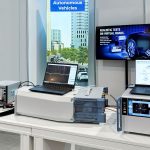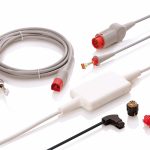By Alejandro Buritica, Semiconductor Marketing Specialist, National Instruments
The new air interface, dubbed 5G New Radio (NR), is being developed to support a wide variety of services and devices on 5G; it promises to provide significant benefits for mobile networks, including improved performance, flexibility, scaleability and efficiency.
With the 5G rollout in the UK set for 2020, companies have already started to invest in this technology. Ericsson recently struck a deal with T-Mobile to provide its latest 5G New Radio hardware and 3GPP (3rd Generation Partnership Project) for $3.5bn. However, as companies around the world continue to work on introducing 5G, they are faced with numerous technical design challenges. Here are the top five technical benefits that 5G NR provides, looking at how this global communication standard will deliver reliable, data-rich and highly-connected applications.
5G NR Waveforms CP-OFDM: Downlink and Uplink
Recently, researchers have been investigating different multicarrier waveforms, proposing them for 5G radio access. Waveforms that use orthogonal frequency division multiplexing (OFDM) work well for time division duplex operation. They support delay-sensitive applications and have demonstrated successful commercial implementation with efficient processing of ever-larger bandwidth signals. Also, the high spectral efficiency and multiple-input, multiple-output (MIMO) compatibility that OFDM signals can achieve helps meet the extreme data rate and density coverage needs of a new global cellular communications standard.
Furthermore, thanks to channel estimation and equalisation techniques, OFDM waveforms show great resiliency against frequency-selective channels. By attaching a copy of the end of the OFDM symbol to the beginning of the symbol (a cyclic prefix), a receiver can better tolerate synchronisation errors and prevent inter-symbol interference; see Figure 1.

The 3GPP settled on using the cyclic prefix OFDM (CP-OFDM) as the waveform of choice for 5G downlink and uplink, with modulation schemes up to 256-QAM.
DFT-S-OFDM: Higher Efficiency Uplink
OFDM waveforms suffer from high peak-to-average power ratio (PAPR). Because the RF power amplifier consumes the most power within a mobile device, system designers needed a type of waveform that could support high-efficiency amplifier operation while meeting the spectral demands of 5G applications. As a result, for uplink, NR offers user equipment (UE) the option of CP-OFDM or a hybrid format waveform called Discrete Fourier Ttransform Spread OFDM (DFT-S-OFDM).
Based on this technology, the transmitter modulates all subcarriers with the same data, and it incorporates a lower PAPR with the multipath interference resilience and flexible subcarrier frequency allocation that OFDM provides.
Flexible Subcarrier Spacing and Frame Structure
Multiple frequency bands ranging from existing cellular bands (< 3GHz) to wider bands between 3GHz and 5GHz, and up to the millimeter wave (mmWave) region of the spectrum, represent a completely new aspect of 5GNR. Figure 2 shows the current bands defined for NR operation above 6GHz.

As the carrier frequency increases, so does the system phase noise. For example, looking on the carrier phase noise plot of Figure 3, the difference in phase noise between a carrier at 1GHz and 28GHz is about 20dB. This phase noise increase would make it very difficult for a receiver to demodulate OFDM waveforms with the narrow, fixed subcarrier spacing (SCS) and symbol duration of LTE at mmWave frequencies.
Additionally, in mobility scenarios, the channel coherence time decreases as the carrier frequency increases, due to Doppler shift effects.

Therefore, at higher carrier frequencies the system has less time to measure the channel and finish a single slot transmission. Using a narrow subcarrier spacing at mmWave frequencies would result in very high error vector magnitude (EVM) and considerable performance degradation.
The 3GPP standardised on a flexible subcarrier spacing approach that scales the space between orthogonal subcarriers, starting with the 15kHz subcarrier spacing of LTE; see Figure 4. One of the fundamental reasons for leveraging the LTE numerology has to do with the ability of NR deployments to coexist and be time-aligned with LTE networks during the first deployments.

The NR subcarrier spacing scales according to the following formula:

The smallest physical resource block (PRB) consists of 12 subcarriers. Figure 5 illustrates the NR channel PRBs and guard bands.

More Scaleable and Flexible Frame Structure
5G NR has a flexible frame structure. NR slots have 14 OFDM symbols (although there is a special case for 60kHz SCS with an extended CP and twelve OFDM symbols). Since OFDM symbol duration has an inversely-proportional relationship with SCSs, the duration of the slots scales down as SCS increases. The frame structure numbers the slots and groups them into subframes of 1ms duration. Figure 6 shows the standard NR slot and frame structure.
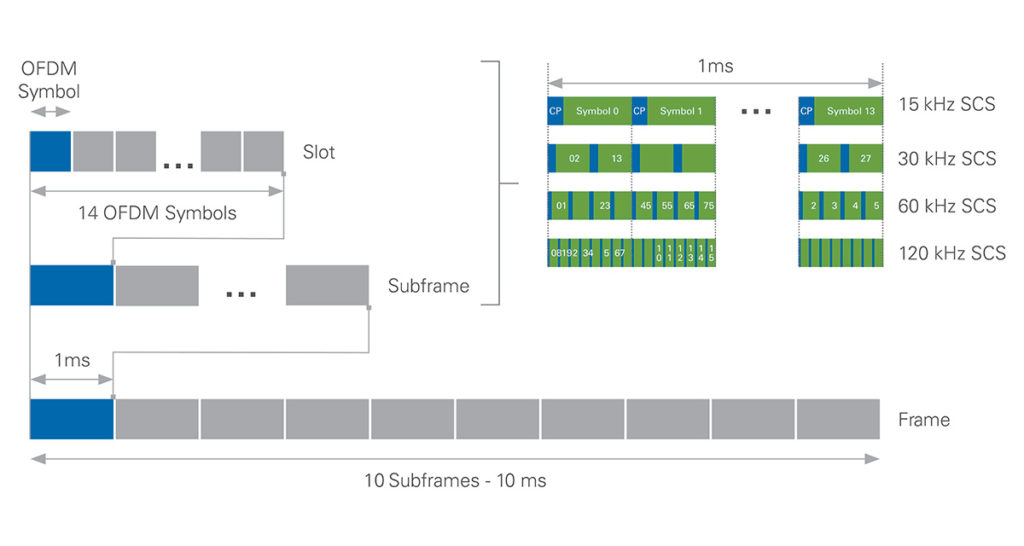
MIMO
5G NR plans to take full advantage of the distributed and uncorrelated spatial location of multiple users to multiplex users in space and increase the spectrum efficiency.
Thanks to multi-user MIMO (MU-MIMO) technology, the gNB (base station) sends simultaneous data streams to different users, maximising the signal strength at each user’s location, while presenting minimum signal strength (a null) in the directions of the other receivers. Consequently, the gNB talks to multiple UEs independently and simultaneously, as Figure 7 shows.

Massive MIMO for 5G
A Massive MIMO configuration takes place when a system has many times more gNB antennas than the number of UE per signalling resource. The large number of gNB antennas relative to the number of UE can create huge gains in spectral efficiency, and enable the system to serve many more devices simultaneously within the same frequency band, compared to today’s 4G systems. National Instruments (NI), along with industry leaders such as Samsung, continues to demonstrate the viability of Massive MIMO systems with its platform of software-defined radio and flexible software for rapid wireless prototyping.
MmWave for 5G
5G systems operating at 28GHz or above have the benefit of having more available spectrum for larger channels. Although there is less spectral crowding at these frequencies than below 6GHz, there are very different propagation effects, such as higher free-space path loss and atmospheric attenuation, weak indoor penetration and poor diffraction around objects.
To overcome these undesirable effects, mmWave antenna arrays can focus their beams and take advantage of the antenna array gain. Fortunately, the size of these antenna arrays decreases as the frequency of operation increases, allowing for a mmWave antenna array with many elements taking up the same area space as single sub-6 GHz element, as shown in Figure 8.
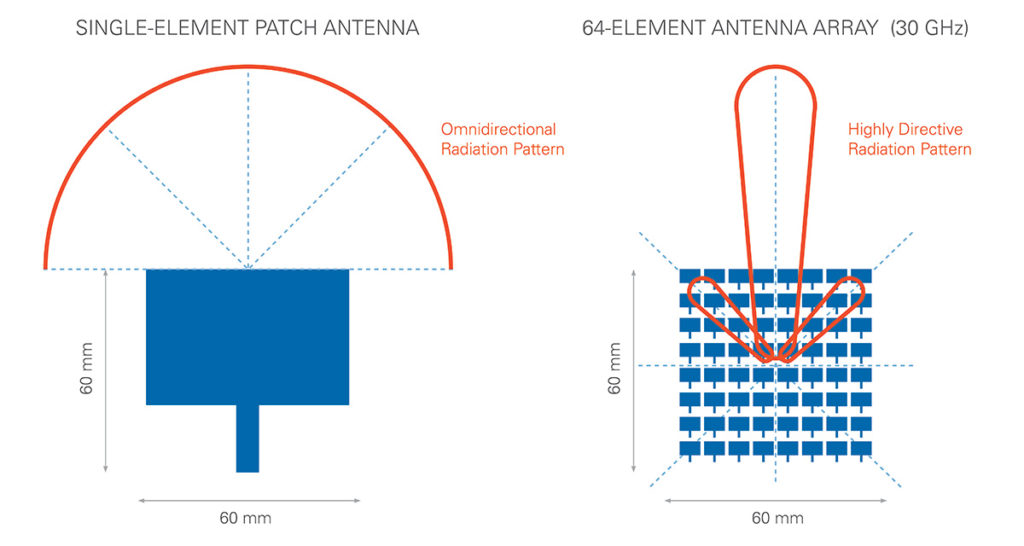
The channel coherence-time decreases significantly at mmWave frequencies, placing tough restrictions on mobility applications. Researchers continue to investigate new ways to improve UE mobility at mmWave frequencies, but most likely the first 5G mmWave systems will serve fixed wireless access applications, such as backhaul, sidelink and static home connections.
Bandwidth Parts
In the future, a wide range of 5G applications will need to operate successfully across many different bands with varied spectrum availability.
An example is a situation in which a UE with limited RF bandwidth operates alongside a more powerful device that can fill a whole channel using carrier aggregation, as well as a third device that can cover the whole channel with a single RF chain.
Wide bandwidth operation has a direct effect on the data rates that users can experience, but it comes at a cost. When UEs don’t need high data rates, using wide bandwidth leads to inefficient use of RF and baseband processing resources. However, 5G NR introduces the new concept of bandwidth parts (BWPs) where the network can negotiate for certain UE to occupy one wideband carrier, and, separately, it can configure another UE with a subset of contiguous resource blocks.
This creates a greater diversity of devices with varying capabilities sharing the same wideband carrier. This kind of flexible network operation that adjusts to a UE’s differing RF capability does not exist in LTE.
Figure 9 shows the allocation of two BWPs (BWP 1 and BWP 2) to one UE, while reserving a third, full-channel, overlapping BWP (BWP 3) for potential use by another higher-bandwidth UE or application.
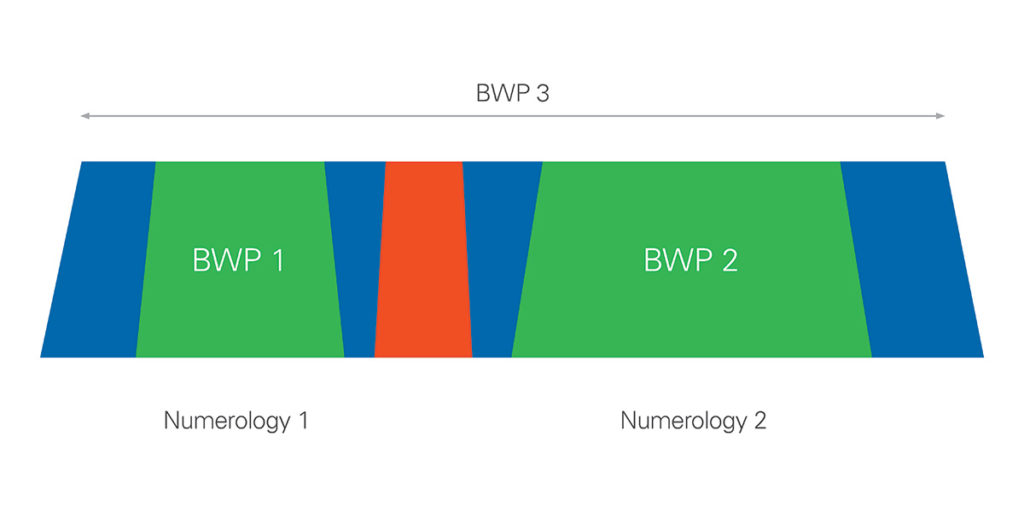
For example, using BWPs, NR can support UEs with narrow RF capabilities and reduce energy consumption when a device doesn’t require full bandwidth operation.
Into the Future
Thanks to higher bandwidth channels and multiple numerology options, NR systems will operate in both sub-6GHz and mmWave bands with appropriate handling of multi-path delay spread, channel coherence time and phase noise.
Latest developments in massive MIMO and beamforming technology will enable NR to maximise spectral efficiency and guarantee better quality of service for more users. Additionally, considering the commercial practicalities of deploying different UEs with different RF capabilities, the new concept of BWP in NR will lead to more energy-efficient UE operation and superior spectrum management. And with less than two years until the UK rollout of 5G, creating the next generation of 5G devices presents a significant design and test challenge.
However, one thing we do know is that employing a platform-based approach to design, prototype and test wireless technologies will be a key factor in turning 5G into reality within the next decade.


